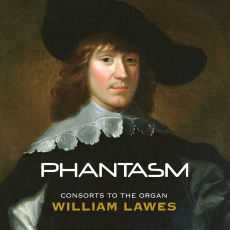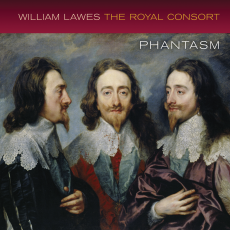Phantasm - Lawes: The Royal Consort & Consorts to the Organ - Fanfare
Lawes's Royal Consort was highly regarded during the time of Charles I, as a mature example of its composer's compositional gifts and quixotic musical personality. Listeners familiar with his music will know what to expect. Those who aren't will discover in The Royal Consort a kind of early 17th century equivalent of Ravel's waltz works: part dance, part parody, after repeated hearing as witty as upon an initial, superficial acquaintance it is compulsively tuneful. Though it contains only dances and no fantasias, the spirit of the English fantasia informs every dance through its composer's whimsy, which sometimes appears as fewer or extra measures than expected to oddly trip up the meter, as sudden and wholly unanticipated modulations, off-kilter canonic entries, or the introduction of brief motifs that resemble barnyard sounds.
Lawes composed two versions of The Royal Consort. (The title doesn't indicate approval by the King, though Lawes was a favorite of his. Rather, it was added after the fact, when the English Civil War broke out, and everybody was taking sides.) One, for four viols and theorbo, is the version recorded here for the first time. The other, which has been assumed to follow it, has two violins, two bass viols, and two theorbos, with several musical additions: four fantasias to lead off the score, and four lighter dances. The liner notes argue persuasively that the viols-and-theorbo version is superior, a point I've noticed in concert performances, though lacking the obviously far greater familiarity Phantasm has with the works. Lawes in a word regularized his music in the violin version, removing some of its quirky humor and character, as well as thickening its textures in a way that harmed the clarity of its counterpoint.
The performances are exemplary. I've commented in past reviews of Phantasm about the broad-breathed span of their bowing and attention to rhythmic detail. Both are much in evidence here, as is their ability to keep each musical line distinct in both the richest chords and most complex imitative passages. They play with the kind of ensemble awareness that only comes with long practice and great familiarity, not merely with the music but with one another's music making. It is no exaggeration to say that as soon as this set finished, I set it to play again, and not just because of the music, either. To listen to Phantasm is to enjoy one of life's fine musical pleasures.
Mention must be made as well of the essay by Laurence Dreyfus, enclosed with the set. These are too accomplished to refer to as liner notes. Some musical analysis of favorites, discussions of each of the dance types, an examination of Lawes's musical style and the work's two versions, finely descriptive writing, historical details, Burney bashing: it's got it all.
Previously, Phantasm recorded the eloquent Consorts to the Organ-a work which apparently bypassed the radar of everyone here at Fanfare-on Linn CKD 399. That disc included as much as one CD could hold, with the rest, ten pieces in all, added to this 2-CD set. Phantasm has also chosen to include three dances that were rejected by Lawes for The Royal Consort, for elements that kept them below the extremely high standards he set himself for the work. The result are two very full discs that make extremely fine listening, and just secured itself a position in my current Want List. Well done.


